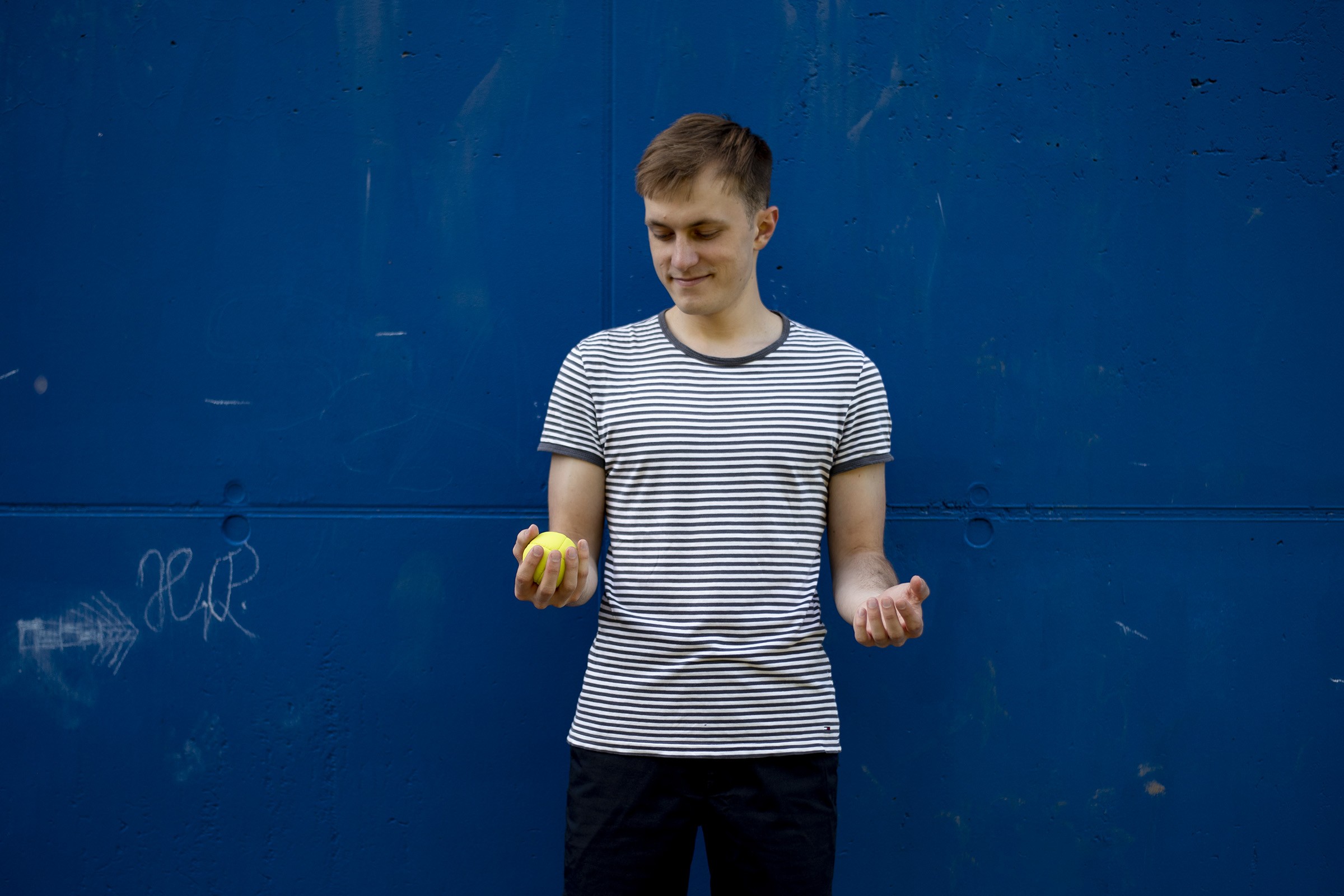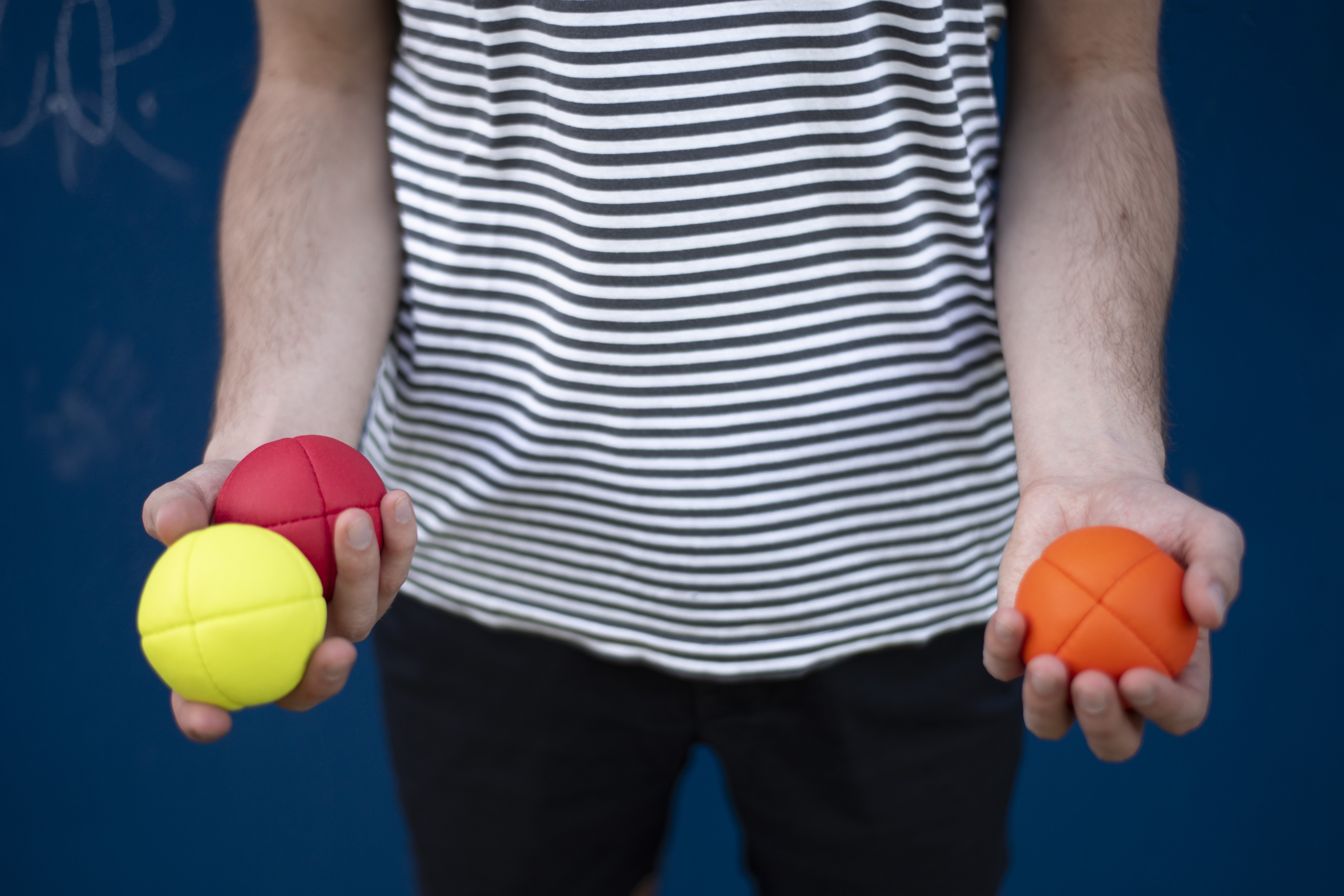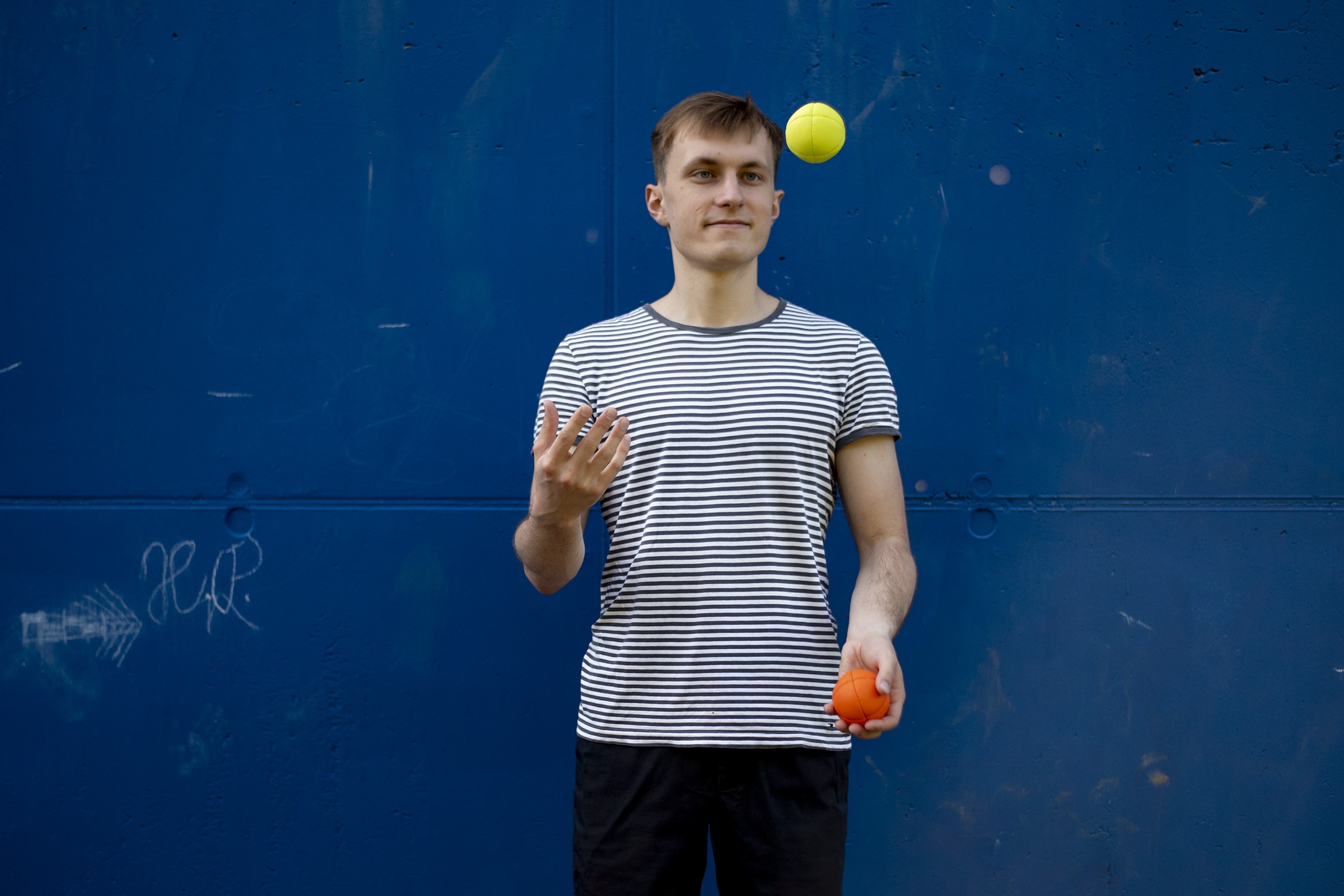Want to learn how to juggle? This comprehensive guide, brought to you by LEARNS.EDU.VN, breaks down the process into easy-to-follow steps, helping you master the art of juggling quickly. We’ll cover everything from basic throws to advanced techniques, making learning fun and accessible. Explore the world of object manipulation and discover tips for efficient juggling practice.
1. What Is Juggling And Why Learn It?
Juggling involves tossing and catching objects in a continuous flow, demonstrating control and coordination. It’s more than just a fun activity; it offers numerous cognitive and physical benefits.
1.1. Benefits of Juggling
Learning how to juggle enhances cognitive functions, improves coordination, and provides stress relief.
| Benefit | Description |
|---|---|
| Cognitive Skills | Enhances focus, concentration, and problem-solving abilities. Studies show juggling can increase grey matter in the brain, particularly in areas related to visual-motor skills. |
| Motor Skills | Improves hand-eye coordination, dexterity, and reflexes. |
| Stress Reduction | Offers a meditative effect, reducing stress and anxiety. The repetitive motion and focus required can help clear the mind. |
| Physical Fitness | Provides a gentle form of exercise, improving balance and posture. |
| Creativity | Encourages creative thinking and improvisation as you explore different patterns and techniques. |
| Confidence | Boosts self-esteem and confidence as you master a new skill. |






1.2. Types of Juggling
From simple patterns to complex routines, juggling offers a wide range of styles to explore.
| Type | Description |
|---|---|
| Ball Juggling | Involves tossing and catching balls in various patterns, such as the cascade, fountain, and shower. |
| Club Juggling | Uses clubs instead of balls, adding a visual element with spinning and throwing techniques. |
| Ring Juggling | Employs rings, focusing on throwing and catching with precision and flair. |
| Contact Juggling | Manipulates objects (usually balls) without throwing them, creating the illusion of objects floating on the body. |
| Siteswap | A notation system used to describe and learn juggling patterns. |
2. What You Need to Start Juggling
Before you begin, gather the necessary equipment and set up a suitable practice environment.
2.1. Essential Equipment
Having the right juggling equipment can make the learning process smoother and more enjoyable.
| Item | Description |
|---|---|
| Juggling Balls | Start with three beanbag-style balls. These are soft, easy to catch, and won’t roll away when dropped. Choose balls that fit comfortably in your hand, typically around 2.5 inches in diameter and weighing about 120-130 grams each. LEARNS.EDU.VN recommends beanbags for beginners. |
| Juggling Clubs | For club juggling, select clubs that are lightweight and well-balanced. Look for clubs with a durable handle and a smooth body for comfortable gripping and throwing. |
| Juggling Rings | Opt for plastic rings that are easy to grip and throw. The diameter of the rings should be appropriate for your hand size, usually between 12 and 14 inches. |
| Practice Space | Choose a spacious area with a soft surface like grass or carpet to cushion falls and prevent damage to the juggling objects. Ensure the area is free from obstacles and distractions. A room with high ceilings is ideal. |
| Comfortable Attire | Wear comfortable clothing that allows free movement. Avoid loose sleeves or accessories that could interfere with your juggling. |
2.2. Setting Up Your Practice Space
A conducive practice environment can significantly impact your learning progress.
- Choose a Location: Select a room or outdoor area with plenty of open space.
- Ensure Good Lighting: Adequate lighting is essential for clear visibility.
- Clear Obstacles: Remove any furniture or objects that could obstruct your movements.
- Soft Surface: Practice on a soft surface to minimize impact when dropping balls.
- Minimize Distractions: Find a quiet place where you can focus without interruptions.
3. Basic Juggling Techniques
Mastering the basics is crucial for building a solid foundation in juggling.
3.1. The One-Ball Toss
Start by practicing with a single ball to develop a feel for the proper throwing technique.
- Grip: Hold the ball in your dominant hand.
- Stance: Stand with your feet shoulder-width apart, knees slightly bent.
- Throw: Toss the ball from one hand to the other in an arc, aiming for eye level.
- Catch: Catch the ball in your other hand, letting it fall gently into your palm.
- Practice: Repeat this exercise until you can consistently throw and catch the ball smoothly.
3.2. The Two-Ball Exchange
The two-ball exchange is a fundamental juggling move that involves throwing and catching two balls alternately.
- Starting Position: Hold one ball in each hand.
- First Throw: Throw one ball from your dominant hand in an arc towards the opposite hand.
- Second Throw: As the first ball reaches its peak, throw the second ball from your other hand, underneath the first ball, towards the opposite hand.
- Catching: Catch the first ball in your non-dominant hand and the second ball in your dominant hand.
- Practice: Practice this exchange until you can perform it smoothly and consistently.
3.3. The Three-Ball Cascade
The cascade is the most common and recognizable three-ball juggling pattern.
- Starting Position: Hold two balls in your dominant hand and one ball in your non-dominant hand.
- First Throw: Throw one ball from your dominant hand in an arc towards your non-dominant hand.
- Second Throw: As the first ball reaches its peak, throw the ball from your non-dominant hand in an arc towards your dominant hand.
- Third Throw: When the second ball reaches its peak, throw the second ball from your dominant hand (the one you were holding) in an arc towards your non-dominant hand.
- Catching: Catch each ball as it falls, maintaining the continuous pattern.
- Practice: Practice this cascade pattern until you can perform it smoothly and consistently.
4. Step-by-Step Guide to Learning the Three-Ball Cascade
Follow this detailed guide to master the three-ball cascade, the cornerstone of juggling.
4.1. Step 1: The Throw
Begin by perfecting the basic throw, ensuring accuracy and consistency.
- Starting Position: Hold one ball in your dominant hand. Stand with your elbows bent at 90 degrees and your palms facing up.
- The Throw: Toss the ball to your other hand using an upward movement of your forearm, not your wrist or entire arm.
- Elbow Position: Keep both elbows close to your hips.
- Trajectory: The peak of the throw should be at eye level. The angle of the throw should ensure the ball lands where your non-dominant hand is waiting.
- Catching: Do not reach for the ball; let it fall into your palm. If the throw is inaccurate, move your body instead of catching in an uncomfortable position.
4.2. Step 2: The Exchange
The exchange teaches you to alternate throws between hands, a crucial skill for juggling.
- Starting Position: Take two balls, ideally of different colors, and hold one in each hand.
- First Throw: Throw the first ball (e.g., yellow) from your dominant hand as in Step 1.
- Second Throw: Once the first ball is at its peak, throw the second ball (e.g., orange) from your non-dominant hand “underneath” the first one (an inverse throw).
- Trajectory: Ensure the trajectories are not identical to avoid collision. Each trajectory should be shifted towards the catching hand side.
- Catching: Catch the first ball (yellow) with your non-dominant hand.
- Final Catch: Catch the second ball (orange) with your dominant hand.
- Alternating Sides: Practice starting the exchange with your non-dominant hand first, followed by your dominant hand.
4.3. Step 3: The Cascade
Combine the skills from the previous steps to achieve the three-ball cascade.
- Starting Position: Take three balls, holding two in your dominant hand and one in your non-dominant hand. Hold one ball (e.g., yellow) with your thumb, index, and middle finger, and the other (e.g., red) with your ring finger and pinkie.
- First Throw: Toss the first ball (yellow) from your dominant hand.
- Second Throw: As in the exchange, throw the second ball (orange) from your non-dominant hand when the first ball (yellow) is around eye level.
- Catching: Catch the first ball (yellow) in your non-dominant hand.
- Third Throw: When the second ball (orange) is around eye level, throw the third ball (red) from your dominant hand. This is similar to the exchange but on the opposite side.
- Catching: Catch the second ball (orange) in your dominant hand.
- Repeating: Repeat the last four positions continuously to maintain the three-ball cascade.
5. Tips for Beginner Jugglers
Enhance your learning experience with these helpful tips and strategies.
5.1. Avoiding the Two-Ball Shower
The shower pattern involves throwing from one hand and zipping from the other, forming a circular shape. While it’s a fun trick, it’s not recommended for beginners.
- Focus on the Exchange: Beginners often intuitively start with a two-ball shower, which involves throwing a ball from one hand and zipping the second ball from the other. However, this doesn’t teach the important aspect of focusing on multiple balls in the air.
- Practice the Exchange: Instead of the shower, concentrate on the exchange to learn how to focus on more than one ball. You can revisit the shower later once you are comfortable with the cascade.
5.2. Picking Up Balls Efficiently
Reduce strain by learning efficient ways to pick up dropped balls.
- Kneeling or Standing Near a Bed: Practice juggling while kneeling or standing near a bed. This reduces the need to bend over each time you drop a ball.
- Kicking Balls Up: Learn to kick the balls up with your feet. This prevents back strain and keeps you in a juggling rhythm.
5.3. Breaking Down Goals
Divide larger goals into smaller, manageable steps to stay motivated.
- Smaller Bites: Break down big goals into smaller steps to maintain motivation.
- Incremental Practice: If transitioning from the exchange to the cascade feels overwhelming, start by stopping at a certain number of throws. Begin with three throws, then progress to four, five, and so on.
5.4. Investing in Quality Juggling Balls
Good equipment can significantly improve your juggling experience.
- Comfortable Balls: Choose juggling beanbags that fit nicely in your hands and aren’t slippery.
- Aesthetic Appeal: Juggling is more enjoyable with good-looking equipment.
6. Common Mistakes to Avoid When Learning to Juggle
Avoid these common pitfalls to accelerate your progress and prevent frustration.
| Mistake | Solution |
|---|---|
| Inconsistent Throws | Practice throwing each ball to the same height and position consistently. |
| Reaching for the Balls | Let the balls fall into your hands instead of reaching for them. Adjust your body position if necessary. |
| Rushing the Pattern | Slow down and focus on each throw and catch. Speed will come with practice. |
| Using Stiff Arms | Keep your arms relaxed and use a smooth, fluid motion. |
| Not Practicing Regularly | Set aside time each day to practice, even if it’s just for a few minutes. Consistency is key. |
| Ignoring Basic Drills | Don’t skip the one-ball and two-ball drills. They build the foundation for more complex patterns. |
| Neglecting Body Position | Maintain a stable and balanced stance. Avoid leaning forward or backward. |
| Overlooking the Importance of Rest | Give your body adequate rest to prevent fatigue and injury. |
| Not Seeking Feedback | Ask experienced jugglers for advice and watch videos to learn new techniques. |
| Getting Discouraged by Drops | Drops are a normal part of learning. Don’t get discouraged; keep practicing. |
7. Advanced Juggling Techniques
Once you’ve mastered the basics, explore these advanced techniques to challenge yourself further.
7.1. Siteswap Notation
Siteswap is a numerical notation system used to describe juggling patterns.
- Understanding Siteswap: Siteswap notation uses numbers to represent the height and timing of throws in a juggling pattern.
- Basic Patterns: Learn to read and interpret common siteswap patterns, such as 3 (the cascade), 441 (a variation of the cascade), and 531 (a more complex pattern).
- Creating Patterns: Use siteswap to create your own juggling patterns and share them with other jugglers.
7.2. Juggling with Clubs
Club juggling adds a new dimension to the art of juggling.
- Club Basics: Learn the basic club throws and catches, focusing on proper grip and rotation.
- Club Patterns: Practice common club juggling patterns, such as the one-club spin, two-club exchange, and three-club cascade.
- Advanced Techniques: Explore more advanced club juggling techniques, such as passing, multiplexes (throwing multiple clubs from one hand at the same time), and body throws.
7.3. Juggling with Rings
Ring juggling requires precision and coordination.
- Ring Basics: Learn the basic ring throws and catches, focusing on accuracy and timing.
- Ring Patterns: Practice common ring juggling patterns, such as the one-ring flip, two-ring exchange, and three-ring cascade.
- Advanced Techniques: Explore more advanced ring juggling techniques, such as under-the-leg throws, back crosses, and neck catches.
8. Maintaining Motivation and Progress
Stay motivated and track your progress to achieve your juggling goals.
8.1. Setting Realistic Goals
Set achievable goals to maintain motivation and track your progress.
- Start Small: Begin with simple goals, such as mastering the one-ball toss or the two-ball exchange.
- Incremental Goals: Gradually increase the difficulty of your goals as you improve.
- Specific Goals: Set specific, measurable, achievable, relevant, and time-bound (SMART) goals.
8.2. Tracking Your Progress
Keep a record of your practice sessions and milestones.
- Journaling: Keep a juggling journal to record your practice sessions, noting any challenges and successes.
- Video Recording: Record yourself juggling to identify areas for improvement and track your progress over time.
- Milestone Tracking: Celebrate your achievements as you reach each milestone.
8.3. Joining a Juggling Community
Connect with other jugglers for support and inspiration.
- Local Clubs: Join a local juggling club or organization to meet other jugglers and learn new techniques.
- Online Forums: Participate in online juggling forums and communities to share tips, ask questions, and connect with jugglers from around the world.
- Juggling Festivals: Attend juggling festivals and events to see professional jugglers perform, take workshops, and network with other enthusiasts.
9. Juggling for Different Age Groups
Juggling is a versatile activity that can be adapted for different age groups and skill levels.
9.1. Juggling for Kids
Introduce children to juggling with fun and engaging activities.
- Start with Scarves: Begin with juggling scarves instead of balls. Scarves float slower, making them easier for kids to catch.
- Simple Games: Play simple juggling games, such as throwing and catching scarves with a partner.
- Positive Reinforcement: Encourage children with positive feedback and rewards for their efforts.
9.2. Juggling for Adults
Adults can benefit from juggling as a form of exercise and mental stimulation.
- Structured Practice: Follow a structured practice routine to learn new skills and improve your technique.
- Cross-Training: Combine juggling with other forms of exercise, such as yoga or Pilates, to improve balance and coordination.
- Mental Challenges: Use juggling to challenge your mind and improve your cognitive skills.
9.3. Juggling for Seniors
Seniors can maintain their physical and mental health through juggling.
- Gentle Exercises: Start with gentle juggling exercises to improve range of motion and coordination.
- Adaptive Equipment: Use adaptive juggling equipment, such as larger balls or lighter clubs, if needed.
- Social Activities: Participate in juggling groups or classes to socialize and stay active.
10. The Science Behind Juggling
Understand the cognitive and physical benefits of juggling through scientific research.
10.1. Cognitive Benefits
Studies have shown that juggling can improve cognitive functions, such as memory, attention, and spatial awareness. A study by Draganski et al. (2004) at the University of Regensburg found that learning to juggle increased grey matter in the brain’s visual-motor areas.
| Cognitive Benefit | Description |
|---|---|
| Improved Memory | Juggling enhances working memory by requiring you to remember and execute complex patterns. |
| Enhanced Attention | Juggling improves attention span by requiring you to focus on multiple objects simultaneously. |
| Spatial Awareness | Juggling enhances spatial awareness by requiring you to track the position and movement of objects in space. |
10.2. Motor Skill Development
Juggling requires precise motor skills and coordination, leading to improved dexterity and reflexes. A study published in Experimental Brain Research found that juggling training improved motor coordination and reduced reaction time.
| Motor Skill | Description |
|---|---|
| Hand-Eye Coordination | Juggling requires you to coordinate the movements of your hands with what your eyes see, improving overall hand-eye coordination. |
| Dexterity | Juggling enhances dexterity by requiring you to make precise and controlled movements with your hands and fingers. |
| Reflexes | Juggling improves reflexes by requiring you to react quickly to the movement of objects in the air. |
10.3. Stress Reduction
Juggling can be a form of stress relief, providing a meditative effect and reducing anxiety. Engaging in repetitive, rhythmic activities like juggling can lower cortisol levels and promote relaxation.
| Stress Reduction Technique | Description |
|---|---|
| Meditative Effect | Juggling provides a meditative effect by requiring you to focus on the present moment, clearing your mind of other thoughts and worries. |
| Anxiety Reduction | Juggling reduces anxiety by providing a sense of accomplishment and control. As you master new patterns and techniques, you gain confidence and reduce feelings of stress and uncertainty. |
FAQ: Frequently Asked Questions About Juggling
Get answers to common questions about learning and practicing juggling.
1. Is juggling difficult to learn?
Juggling can be challenging at first, but with consistent practice and the right techniques, anyone can learn it.
2. How long does it take to learn to juggle three balls?
Most people can learn the three-ball cascade within a few weeks of regular practice, but it varies from person to person.
3. What are the best juggling balls for beginners?
Beanbag-style juggling balls are the best for beginners because they are soft, easy to catch, and don’t roll away when dropped.
4. How often should I practice juggling?
Practice juggling regularly, even if it’s just for a few minutes each day. Consistency is key to improving your skills.
5. What should I do if I keep dropping the balls?
Drops are a normal part of learning. Don’t get discouraged; just pick up the balls and keep practicing. Focus on making consistent throws and catches.
6. Can juggling improve my brain function?
Yes, studies have shown that juggling can improve cognitive functions such as memory, attention, and spatial awareness.
7. Is juggling a good form of exercise?
Juggling provides a gentle form of exercise, improving balance, posture, and hand-eye coordination.
8. What are some advanced juggling tricks I can learn?
Some advanced juggling tricks include siteswap patterns, club juggling, ring juggling, and contact juggling.
9. How can I find a juggling community near me?
You can find a juggling community by searching online for local juggling clubs or organizations, or by attending juggling festivals and events.
10. What is siteswap notation?
Siteswap is a numerical notation system used to describe juggling patterns. It allows jugglers to communicate and learn new patterns more easily.
Ready to take your juggling skills to the next level? Visit LEARNS.EDU.VN for more comprehensive guides, expert tips, and in-depth courses designed to help you master the art of juggling. Whether you’re a beginner or an experienced juggler, our resources will provide you with the knowledge and skills you need to succeed.
Contact us:
- Address: 123 Education Way, Learnville, CA 90210, United States
- WhatsApp: +1 555-555-1212
- Website: learns.edu.vn

